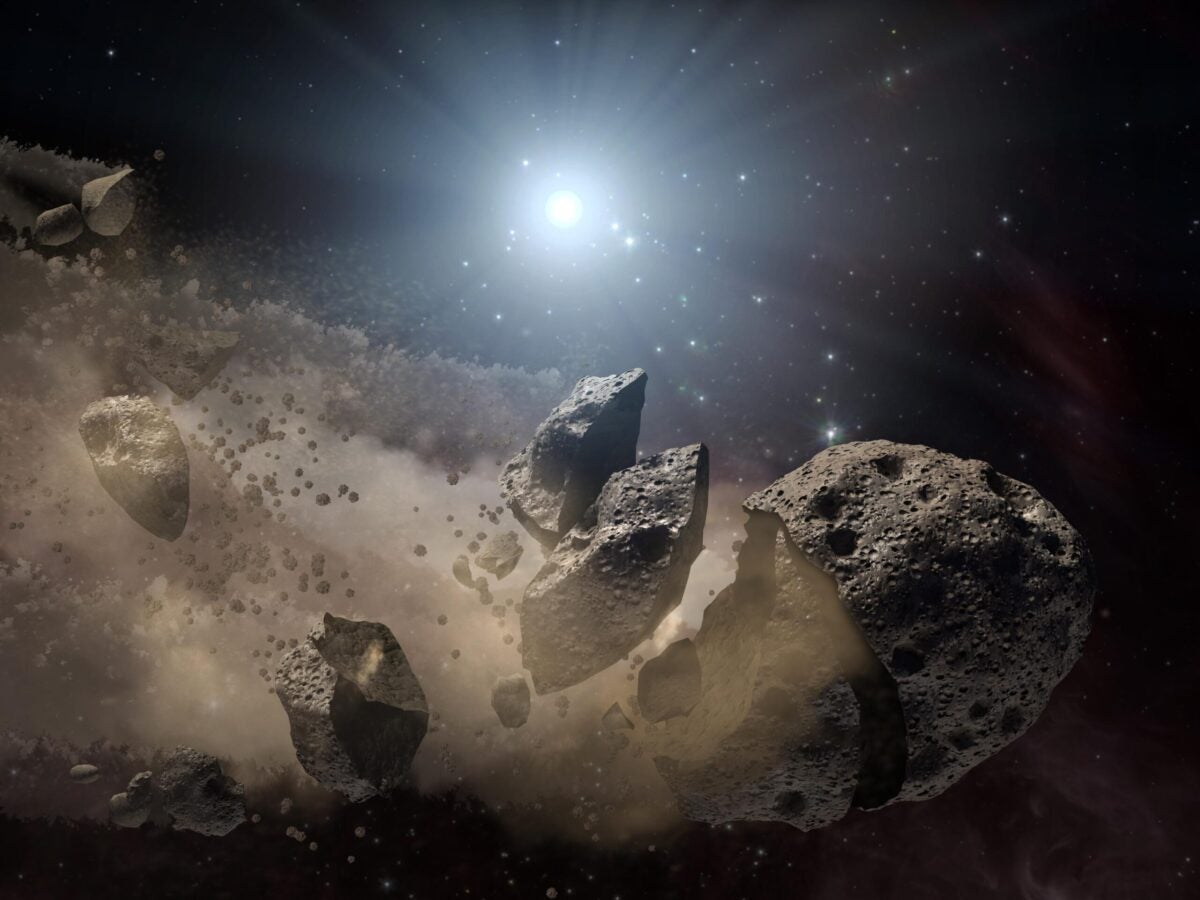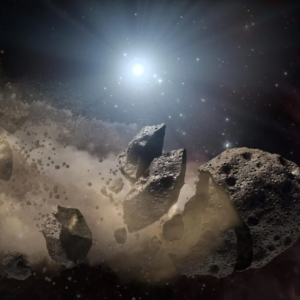A dimple in the Atlantic seafloor could be the sign of another impact.
 An asteroid splits apart while traveling in space, in an artist’s illustration. NASA/JPL-Caltech
An asteroid splits apart while traveling in space, in an artist’s illustration. NASA/JPL-Caltech
When Africa and South America split apart during the Jurassic, birthing the Atlantic Ocean, the separation left a plateau of shallow ocean off the west coast of Guinea. “All the sediments are very flat, almost like a layer cake,” says Uisdean Nicholson, a marine geologist at Heriot-Watt University in Scotland who studies the region to learn about the birth of the Atlantic.
So in 2017, when Nicholson was examining seismic scans of the region taken by oil and gas exploration vessels, an unexpected feature jumped out: a 5-mile-wide dimple buried deep in the cake.
A closer analysis of the site, led by Nicholson and published today in the journal Science Advances, argues that it’s the crater from a meteor as wide as the Eiffel Tower is tall. If it’s confirmed as a crater, it would have crashed into Earth within a million years of the Chicxulub meteor that caused the extinction of the dinosaurs.
Nicholson hunted for other ways to explain the dimple—escaping methane bubbles, tectonic activity, or a volcano. But none of them quite explained the crater’s size, location, and shape. So he turned to cosmic impact experts for help. “Probably every week, somebody sends me circles they spotted on Google Earth, or in seismic data,” says Sean Gulick, an expert in meteor strikes at the University of Texas Institute for Geophysics, and a coauthor on the research. But the dimple, which the team calls the Nadir Crater, passed the tests they threw at it. “Shapes, sizes, even modeling, it’s all fitting,” says Gulick.
To further confirm the explanation, Veronica Bray, a planetary scientist at the Lunar and Planetary Laboratory in Tucson and a member of the team, simulated multiple meteor strikes in different ocean depths. A rock longer than 1,000 feet across, striking the half-mile-deep ocean, created a close approximation to the actual crater. According to the simulation, in the first few seconds after the impact, the rock would have plunged nearly a mile into the ocean floor, vaporizing rocks and water, and sending a tsunami in all directions.
The vibrations from the impact would be so intense that “the rocks or sediment below the seabed become a fluid,” Nicholson says. The rock around the crater would shatter, and “you get this massive vertical column, like you dropped something into a puddle,” he says. “That happens with the water, but it also happens with the rocks below”—leaving a crater with an uplifted mound of solid rock in the middle, like what’s buried under the Guinean seafloor.
Courtesy Veronica Bray.
“The energies involved in this are enormous,” says Gulick. “This is 1000 times the energy of the Tonga eruption. It would generate earthquakes that are magnitude 7.5 or 8.”
Ludovic Ferrière, an impact crater expert from the Natural History Museum Vienna who was not involved in the work, agrees that the shape of the feature is interesting and warrants further investigation—but he’s skeptical of the decision to publish on the basis of seismic images alone. “It’s a very nice proposal,” he says. “”But it’s too preliminary. At the end they may be right, but they may be completely wrong.”
Ferrière—who says that he discussed the crater with Gulick at a bar days before the publication—says that he has found similarly compelling craters. But, without physical evidence, he doesn’t think they pass scientific scrutiny to publish. “To find the killer in a murder, you need DNA or blood,” he says. The same is true for an impact crater: The only hard evidence of a meteor are the presence of “shocked” minerals that form only under the hammer blow of a cosmic strike, or actual spray from the extraterrestrial object.
Drilling from a ship hundreds of feet into the seafloor itself is the only way to be sure. Yet this creates a chicken-egg problem. The International Ocean Discovery Program, the academic institution best equipped to take a sample—“at a cost of several million dollars,” Nicholson writes over email–would do so only after a peer-reviewed paper confirms that it is a good candidate.
The International Ocean Discovery Program’s ship, which can collect core samples under thousands of feet of water and hundreds more feet of rock, will visit the region in 2023. The team has submitted an application for time with the drill, and hopes to analyze samples from the crater in the next few years.
That drilling will also clarify the age of the proposed crater. Based on cores drilled a little over 100 miles from the proposed crater, the site sits right around the K-PG boundary, the line that marks the mass extinction of dinosaurs, pterosaurs, and giant marine reptiles, 65 million years ago. That die-off was caused when the miles-wide Chicxulub meteor smashed into what’s now the Yucatan Peninsula.
But the sound waves the team is relying on in Guinea produce a slightly fuzzy image, which can’t firmly pin down the date. “To the best of our knowledge, we’re at the boundary, but it could be, could be a million years older or younger,” says Nicholson.
If the crater sits right at the boundary, it’s possible that it was caused by a fragment of the Chixculub meteor that broke off on a previous fly-by past Earth, though Gulick thinks this is unlikely. Alternatively, it could have been part of an asteroid swarm that intercepted our planet over the course of thousands of years. Ferrière, for his part, calls these hypotheses “speculation upon speculation”—without confirmation that the Nadir Crater is actually a crater, he says, “it’s like constructing a big castle of stone on something that is not stable.”
A similarly sized meteor hits Earth roughly every 700,000 years, so even if it’s a crater, it’s not necessarily connected to the Chicxulub impact. But Gulick says that documented craters are so rare–there are just over 200 confirmed or likely craters on Earth—that to find one within a million years of Chicxulub would be a surprise.
